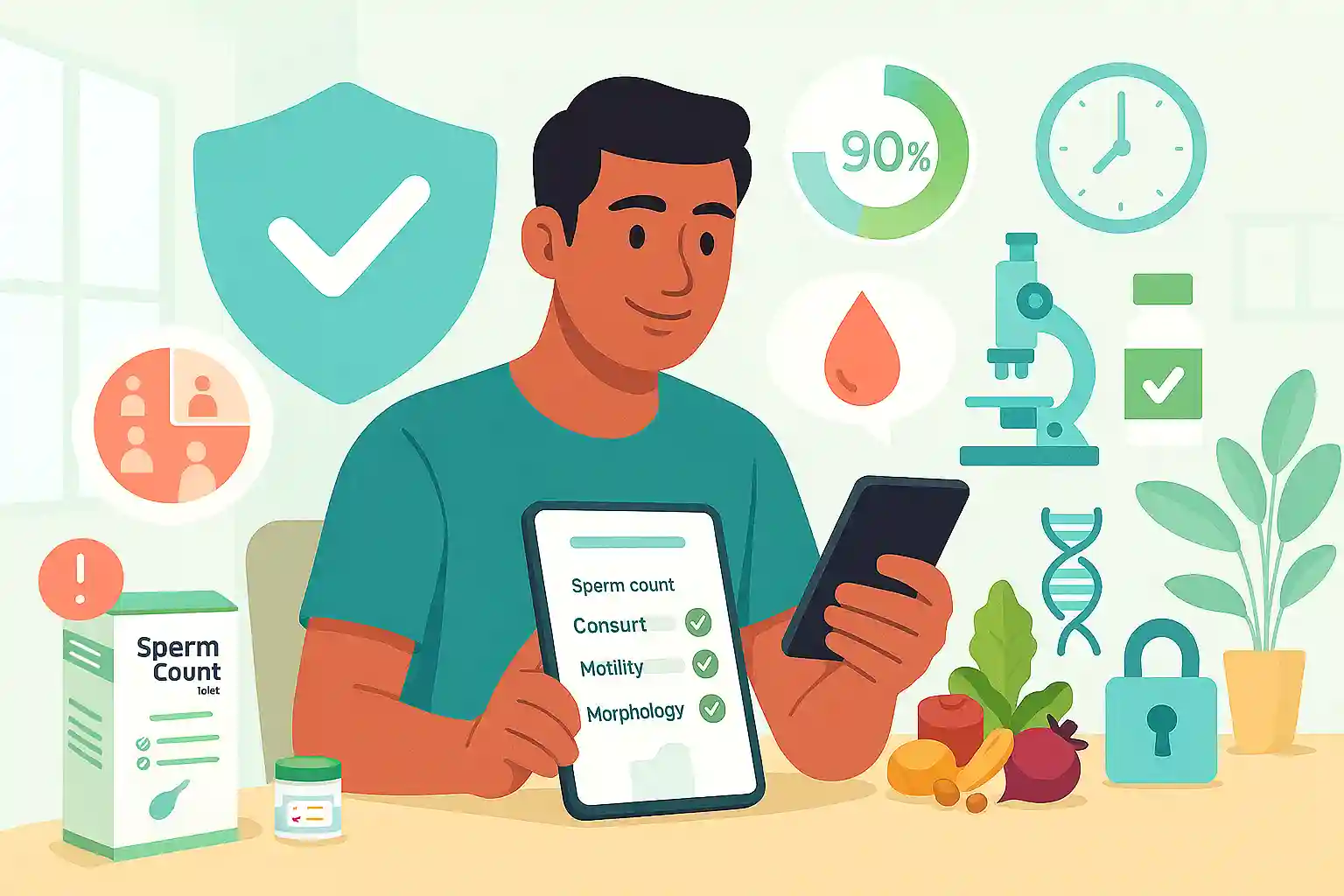Receiving a low sperm count diagnosis can feel like a devastating blow to your dreams of becoming a father. The anxiety, disappointment, and uncertainty that follow are completely understandable. However, it's important to know that a low sperm count—medically called oligospermia—doesn't automatically mean you can't conceive naturally. Many men with low sperm counts successfully father children without medical intervention, and there are numerous strategies to improve your fertility potential.
Understanding Low Sperm Count
Before diving into conception possibilities, it's crucial to understand what low sperm count actually means and how it's diagnosed:
Sperm Count Classifications:
- Normal: 15 million or more sperm per milliliter of semen
- Mild oligospermia: 10-15 million sperm per milliliter
- Moderate oligospermia: 5-10 million sperm per milliliter
- Severe oligospermia: Less than 5 million sperm per milliliter
- Azoospermia: No sperm detected in the ejaculate
Important Facts About Sperm Count:
- Sperm count is just one factor in male fertility—quality matters as much as quantity
- Sperm count can vary significantly between samples and over time
- Many factors besides count affect your ability to conceive naturally
- A single low result doesn't necessarily indicate a permanent problem
- Lifestyle changes can often improve sperm count within 2-3 months
Your Chances of Natural Conception
The good news is that natural conception is often still possible with low sperm count, though the probability varies based on several factors:
Conception Rates with Low Sperm Count:
- Mild oligospermia: 60-80% chance of natural conception within 2 years
- Moderate oligospermia: 30-50% chance of natural conception within 2 years
- Severe oligospermia: 10-30% chance of natural conception, may take longer
- These rates improve significantly with lifestyle modifications and optimal timing
Factors That Increase Your Chances:
- Good sperm motility (movement) and morphology (shape)
- Female partner has normal fertility
- Both partners are under 35 years old
- Optimal timing of intercourse with ovulation
- Healthy lifestyle and stress management
- No other fertility issues present
Beyond Count: Other Critical Sperm Factors
Sperm count is important, but it's not the only factor that determines your fertility potential:
Sperm Motility (Movement):
- Progressive motility: Sperm that swim forward strongly
- Normal: At least 40% of sperm should have good motility
- Strong motility can compensate for lower count
- Poor motility with low count creates more significant challenges
Sperm Morphology (Shape):
- Normal: At least 4% of sperm should have normal shape
- Normal-shaped sperm are more likely to fertilize eggs successfully
- Good morphology can offset lower count numbers
- Abnormal morphology combined with low count may require intervention
Semen Volume and Concentration:
- Total sperm count = concentration × volume
- Low concentration with high volume may still provide adequate total count
- Normal semen volume: 2-5 milliliters per ejaculation
- Very low volume may indicate blockages or other issues
Natural Strategies to Improve Sperm Count
Many lifestyle modifications can significantly improve sperm count and overall fertility within 2-3 months:
Dietary Improvements:
- Increase antioxidant-rich foods: berries, nuts, dark leafy greens
- Add zinc-rich foods: oysters, beef, pumpkin seeds, beans
- Include omega-3 fatty acids: fatty fish, walnuts, flaxseeds
- Eat foods high in folate: asparagus, spinach, citrus fruits
- Consume vitamin C sources: bell peppers, strawberries, broccoli
- Limit processed foods, excessive sugar, and trans fats
Lifestyle Modifications:
- Maintain healthy weight through balanced diet and exercise
- Exercise regularly but avoid excessive intense training
- Quit smoking and limit alcohol consumption
- Manage stress through meditation, yoga, or counseling
- Get 7-8 hours of quality sleep each night
- Avoid recreational drugs and anabolic steroids
Environmental and Heat Avoidance:
- Wear loose-fitting underwear and avoid tight pants
- Limit hot baths, saunas, and hot tubs
- Avoid placing laptops directly on lap for extended periods
- Minimize exposure to chemicals, pesticides, and toxins
- Keep cell phones out of pants pockets when possible
- Take breaks from sitting for long periods
Supplements That May Help
While lifestyle changes are most important, certain supplements have shown promise in improving sperm count:
Evidence-Based Supplements:
- Coenzyme Q10: 200-300mg daily may improve sperm count and motility
- Zinc: 15-30mg daily (with copper to prevent deficiency)
- Vitamin C: 500-1000mg daily for antioxidant protection
- Vitamin E: 400 IU daily, often combined with vitamin C
- Folate: 400-800mcg daily for DNA synthesis
- Selenium: 50-200mcg daily for sperm formation
Additional Supportive Supplements:
- L-carnitine: 1000-3000mg daily for sperm energy
- N-acetyl cysteine (NAC): 600mg daily for antioxidant support
- Vitamin D: 1000-4000 IU daily if deficient
- Omega-3 fatty acids: 1000-2000mg daily EPA/DHA
- Ashwagandha: 300-600mg daily for stress and hormone support
Important note: Always consult with a healthcare provider before starting any supplement regimen, as individual needs vary and some supplements can interact with medications.
Optimizing Timing and Technique
When dealing with low sperm count, optimizing when and how you try to conceive becomes even more important:
Timing Strategies:
- Track your partner's ovulation using multiple methods (apps, ovulation kits, basal body temperature
- Focus intercourse on the fertile window: 3 days before ovulation through ovulation day
- Consider every other day during the fertile window to maintain sperm quality
- Avoid daily ejaculation which may further reduce sperm count
- Time intercourse for when sperm count is typically highest (morning hours)
Technique Considerations:
- Ensure deep penetration during ejaculation to deposit sperm closer to cervix
- Consider positions that may help sperm reach the cervix more effectively
- Avoid lubricants that may harm sperm (use fertility-friendly options if needed)
- Your partner can remain lying down for 10-15 minutes after intercourse
- Maintain 2-5 days of abstinence before fertile window for optimal sperm concentration
Addressing Underlying Causes
Sometimes low sperm count results from treatable underlying conditions:
Medical Causes That Can Be Treated:
- Varicocele (enlarged veins in scrotum): Can be surgically corrected
- Hormonal imbalances: May respond to hormone therapy
- Infections: Treatable with appropriate antibiotics
- Medication side effects: May be reversible by changing medications
- Nutrient deficiencies: Correctable through diet and supplements
- Chronic health conditions: Better management may improve sperm count
When to Seek Medical Evaluation:
- Sperm count below 5 million per milliliter
- No improvement after 3-6 months of lifestyle changes
- Other symptoms suggesting underlying health issues
- Partner is over 35 years old (time becomes more critical)
- History of testicular injury, infection, or surgery
- Signs of hormonal problems (low libido, fatigue, mood changes)
Supporting Your Partner and Relationship
Dealing with fertility challenges affects both partners and requires teamwork:
Communication Strategies:
- Share your feelings openly and encourage your partner to do the same
- Avoid blame and focus on solutions you can work on together
- Discuss timelines and expectations realistically
- Consider couples counseling if fertility stress affects your relationship
- Maintain intimacy that isn't focused solely on conception
- Support each other through the emotional ups and downs
Partner Support:
- Encourage your partner to also optimize her fertility health
- Work together on lifestyle improvements (diet, exercise, stress management)
- Share the responsibility for tracking ovulation and timing
- Be patient and understanding during the process
- Celebrate small improvements and positive steps
- Make decisions about next steps together
When to Consider Additional Help
While natural conception is often possible with low sperm count, there are times when medical assistance may be beneficial:
Consider Fertility Treatment If:
- No pregnancy after 12 months of trying (6 months if partner is over 35)
- Sperm count remains very low despite lifestyle improvements
- Multiple sperm parameters are abnormal (count, motility, morphology)
- Female partner also has fertility issues
- Age factors make time more critical
- Underlying medical conditions require intervention
Treatment Options Available:
- Intrauterine insemination (IUI): Concentrates sperm and places them directly in uterus
- In vitro fertilization (IVF): May be needed if sperm count is very low
- Intracytoplasmic sperm injection (ICSI): Injects single sperm directly into egg
- Sperm retrieval procedures: For men with very low or zero sperm count
- Hormonal treatments: For men with hormonal causes of low count
Success Stories and Realistic Expectations
Many men with low sperm count do successfully conceive naturally, but it's important to maintain realistic expectations:
Realistic Timeline Expectations:
- Natural conception may take longer than average (6-24 months)
- Improvement in sperm count takes 2-3 months due to sperm development cycle
- Some couples conceive quickly despite low count, others need more time
- Consistency with lifestyle changes is more important than perfection
- Progress may be gradual rather than dramatic
Positive Factors to Remember:
- Only one sperm is needed to fertilize an egg
- Even with low count, you likely have millions of sperm available
- Many factors besides count affect fertility
- Lifestyle improvements benefit overall health beyond fertility
- Multiple conception attempts increase cumulative pregnancy rates
- Modern fertility treatments have high success rates if needed
Monitoring Progress and Staying Motivated
Tracking your progress and maintaining motivation throughout the process is crucial:
Monitoring Strategies:
- Repeat semen analysis after 3 months of lifestyle changes
- Keep track of lifestyle modifications and their consistency
- Monitor energy levels, mood, and overall health improvements
- Track conception attempts and timing
- Document any symptoms or health changes
- Regular check-ins with healthcare providers
Staying Motivated:
- Focus on improvements you can control rather than dwelling on numbers
- Celebrate small victories and positive lifestyle changes
- Connect with other men who have faced similar challenges
- Remember that fertility improvement often takes time
- Maintain perspective on your overall life and relationship
- Consider professional counseling if motivation becomes difficult
Hope and Moving Forward
A low sperm count diagnosis can feel overwhelming, but it's important to remember that it's often just one piece of your fertility puzzle. Many men with low sperm counts successfully father children naturally, and even when natural conception doesn't occur quickly, effective treatments are available.
The key is to approach this challenge proactively while maintaining realistic expectations. Focus on the factors you can control—your lifestyle, health, and timing—while staying open to medical assistance if needed. Every step you take toward improving your health not only benefits your fertility but also your overall well-being.
Remember that your worth as a man and future father isn't determined by your sperm count. Many factors contribute to successful conception and pregnancy, and countless couples have overcome fertility challenges to build happy families. Stay committed to the process, communicate openly with your partner, and don't hesitate to seek support when you need it.
Your journey to fatherhood may look different than you originally imagined, but with patience, persistence, and the right approach, your goal of becoming a father is still very much within reach.
References
- https://www.asrm.org/topics/topics-index/male-infertility/
- https://www.ncbi.nlm.nih.gov/pmc/articles/PMC3739880/
- https://pubmed.ncbi.nlm.nih.gov/25837639/
- https://www.who.int/publications/i/item/9789241547789
- https://www.ncbi.nlm.nih.gov/pmc/articles/PMC4717046/
- https://pubmed.ncbi.nlm.nih.gov/27266062/
- https://www.cochranelibrary.com/cdsr/doi/10.1002/14651858.CD004729.pub4/full
- https://academic.oup.com/humrep/article/33/9/1749/5051204
- https://www.fertstert.org/article/S0015-0282(19)30349-X/fulltext30349-X/fulltext)



